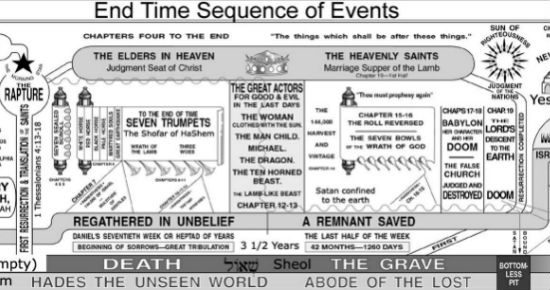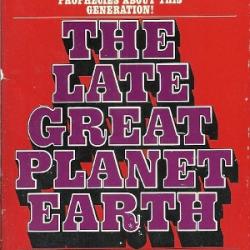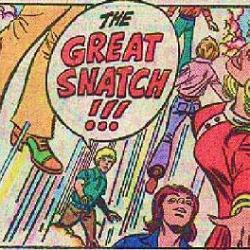Nicolae: The Rise of Antichrist; pp. 318-322
Rayford Steele segues into the final segment of New Hope Village Church’s marathon memorial service for its late pastor, Bruce Barnes. After the altar call and the hour-long session of “sharing” in which various people stood to reaffirm the importance of altar calls, Rayford announces that he will “be summarizing Bruce’s message for this morning, apologizing in advance for reading some of it to you.”
That’s at least the second time Rayford has apologized for himself since beginning the service by saying “a speaker should never apologize for himself.” And he continues in this vein for another page or so, very gradually warming into the actual sermon itself by repeatedly warning his audience that “I am not the preacher he was, so bear with me.” But while Rayford works hard to lower expectations for the sermon to come, Jerry Jenkins works to inflate them, switching to Buck’s point of view for a dose of eager anticipation:
Buck knew what was coming. He had been over the material nearly as many times as Rayford had and had helped condense it. Still, he was excited. People would be inspired by what Bruce believed had happened, what he predicted would happen, and what was yet to come.
“Inspired” seems like an odd choice of word. This is a sermon about the Great Tribulation being delivered to an audience that is going to have to try to live through all the lethal calamities it holds in store. That shouldn’t be inspiring. It should be terrifying.
And it should also be redundant.
The pews of New Hope are packed with post-Rapture converts to Rapture Christianity. These are people who didn’t just get “born again,” but who converted to a very particular form of premillennial dispensationalist “Bible prophecy” faith. These are Revelation and Daniel Christians who you would think have thus been reading Revelation and Daniel for the past 18 months with a desperate urgency.
Here in our world, of course, Revelation and Daniel are difficult texts. They can be confusing, opaque, and bewildering for the modern reader. These are, after all, examples of a literary genre that no longer really exists. Understanding them requires a good bit of study of their contemporary literary and historical context. Without such study, a 21st-century reader of first-century apocalyptic writings is bound to wind up as confused as a first-century reader would’ve been by, say, a 20th-century novel, or by watching The Matrix Reloaded.
But the world of Left Behind is not our world. This is a fictional universe in which a particular sectarian interpretation of Revelation and Daniel is being proved true on a daily basis. It is a world in which every Christian is a Tim-LaHaye Christian.
And for Tim-LaHaye Christians, Revelation and Daniel are not difficult texts at all. That’s the whole point of Tim-LaHaye Christianity — the idea that these texts have a simple, obvious, contemporary meaning that can be easily understood by any contemporary reader. If we accept that framework, that lens for reading Revelation, then we don’t require Bruce Barnes’ assistance in understanding what the text says.
It’s all very simple. There’s going to be a Rapture. (That’s not actually from Revelation but, like, just trust me, OK?) There’ll be this “Rapture” and all the real, true Christians will be whisked off to Heaven for seven years while God rains down wrath and punishment and destruction on everyone left behind. (Why seven years? That’s what Daniel is for.) Anyway, that’s what Revelation is about — about the seven years of the Great Tribulation that starts after the Rapture.
So just open the book of Revelation and start reading. Well, start with chapter 6, really. (All the stuff before that about the seven churches isn’t important because if we read that literally then we know those are not literal churches, but time periods — “dispensations” — and the past doesn’t matter.) From Revelation 6:1 onward it’s just a straight chronology of the Great Tribulation. You’ve got your seven seals, then your seven trumpets, then your seven vials, then Armageddon (which is really from Ezekiel, but just go with it, OK?). That’s your itinerary for the Great Tribulation right there — a list of 21 Very Bad Things that are going to happen and the order in which to expect them.
This is terrible exegesis, but it’s not complicated. LaHaye’s interpretive scheme may be bonkers, but once you accept the bonkers premise, applying that premise becomes very simple. No one who accepts his “Bible-prophecy” framework for reading Revelation is going to need anyone else’s help understanding what that framework says it teaches.
And yet, we’re told, Bruce Barnes has spent months locked in his study, feverishly studying this text in an attempt to penetrate its mysteries. All of that arcane study culminated in his dense, scholarly sermon notes, which were then “condensed” by Rayford and Buck into the revelatory sermon Rayford is about to deliver to the congregation.
This just doesn’t make any sense. I cannot figure out what Bruce was puzzling over during all that time he spent “studying” this prophecy timeline. I cannot figure out why Rayford and Buck needed Bruce’s notes to understand any of this. And I cannot figure out why anyone in New Hope’s congregation would need to hear this sermon.
This weird contradiction isn’t unique to Tim LaHaye, it’s something nearly every “Bible-prophecy scholar” insists on. First, they say, everything they teach is based on a simple, straightforward and literal reading of the text — a meaning easily apparent and accessible to anyone who opens their Bible. But then they also say that they have been studying this simple, obvious meaning for decades, and that we could not possibly hope to understand it on our own without deferring to their superior understanding and having them explain it to us.
Which is it? Because it can’t be both. Either we need to buy their books and attend their conferences, in which case the literal meaning of the text isn’t as clear and obvious as they say. Or else the text is that simple and obvious, in which case no one needs to read — or to write — 200-page books decoding the hidden meanings of this 20-page Bible passage.
Just look at Revelation 6 for yourself. It’s short — just 17 verses, or about 500 words. Here it is in Tim LaHaye’s preferred New King James translation. It lists the first six “seals” of divine judgment. Conquest, slaughter, famine, death, martyrs, ginormous earthquake. Boom, boom, boom, boom, boom, boom. This is not complicated. Any reader can understand that John is providing a sequence of six calamities.
No reader of that chapter, however, will ever learn anything about the Great Tribulation, or the Rapture, or the Antichrist, unless they’ve already been taught about those things elsewhere and learned to impose them on this text. But once you’ve swallowed that simple, simplifying framework, you’re not going to need any help cramming the six “seals” described here into it.
So everyone sitting there in New Hope Village Church, listening to Rayford apologetically stammer his way through Bruce’s sermon notes, should already be familiar with everything Rayford is telling them. Yet — weirdly and irresponsibly — none of them seems to have heard or read any of this before. Bruce Barnes, apparently, has been preaching his way through the Great Tribulation as though it were an Advent Calendar — forbidding his congregation from peeking ahead or from reading Revelation on their own to learn what is about to happen to them all.

That’s why, in more than a year and a half after the Rapture, Bruce never gave his followers even a hint of the sequence of events “prophesied” in Revelation 6. And why he died without ever giving them the slightest warning.
Rayford starts by reading some of the “personal notations” from Bruce’s notes, including his description of the illness he contracted while preaching in Indonesia (international travel is surprisingly easy in the Antichrist’s OWG).
“So,” Rayford added, “we get a glimpse of the ailment that brought him low and which led to his collapse at the church upon his return. As most of you know, he was rushed to the hospital, where it is our belief that he died from this ailment and not from the blast.”
“The blast” there refers to the destruction of the local hospital by the Antichrist’s Global Community Air Force. That was the only suburban airstrike in what turned out to be Nicolae’s global nuclear war on cities — a conflagration claiming the lives of tens of millions of his subjects all over the world. It’s not clear here in our story whether or not this attack on major cities is ongoing. Our heroes and all of their friends are safely back in the suburbs, and so neither they nor the authors have any interest in whether or not their urban neighbors are still being slaughtered wholesale.
Rayford wants everyone to know, though, that even though Bruce’s ailment took his life moments before the bombs started falling, Bruce had fully intended to preach the following Sunday and to offer his prediction that the bombs were about to start falling:
“Bruce has outlined a message here that he believed was particularly urgent, because, as he writes, ‘I have become convinced we are at the end of the 18-month period of peace, which follows the agreement the Antichrist has made with Israel. If I am right, and we can set the beginning of the Tribulation at the time of the signing of the treaty between the nation of Israel and what was then known as the United Nations, we are perilously close to and must prepare for the next ominous and dire prediction in the Tribulation timeline: The Red Horse of the Apocalypse.'”
The coming of the red horse — war and slaughter — is both ominous and dire, yet apparently not so ominous and/or dire that Bruce could be bothered to mention it from the pulpit until just before it arrives. Instead, he’s apparently spent the 18 months since the signing of that peace treaty studiously calculating whether or not 18 months had passed yet, deciding that only then would it be time to allow his congregation a glimpse of the next step in “the Tribulation timeline.”
All that treaty gobbledygook, by the way, is Tim LaHaye settling scores with his “Bible-prophecy” competitors. Those other guys teach that the Great Tribulation begins right after the Rapture, but LaHaye says they’re wrong, wrong, wrong about that and that it doesn’t start until the Antichrist signs a peace treaty with Israel because something-something-Daniel. This is Tim LaHaye’s novel, so of course this fictional portrayal of the “Tribulation timeline” accords with his idea of how it should go, not theirs. But yet again LaHaye seems to think that by producing a fictional portrayal he has actually confirmed his viewpoint in this dispute. He seems to think that writing a fictional story in which the Tribulation begins at the treaty-signing rather than at the Rapture offers proof that he is right and his “Bible-prophecy” rivals are wrong. Does the story he wrote show their prophecy timeline coming true? No. It shows his version coming true. Therefore, he’s right and they’re wrong.
That’s weird. I would spend more time boggling over how incomprehensibly weird it is that Tim LaHaye thinks writing a fictional story constitutes evidence, but I’m too busy boggling over how incomprehensibly weird it is that fans of these books think that reading a fictional story constitutes evidence.
“‘… we are perilously close to and must prepare for the next ominous and dire prediction in the Tribulation timeline: The Red Horse of the Apocalypse. Revelation 6:3-4 indicates that it was granted to the one who sat on it to take peace from the earth, and that people should kill one another; and there was given to him a great sword. In my mind, this is a prediction of global war. It will likely become known as World War III.”
I love how Bruce wrote “in my mind, this is a prediction of global war.” As though this were his independent conclusion, the result of long hours of contemplation and study rather than the unanimous interpretation of everyone who has ever read that verse during the past 2,000 years. Here’s the verse he’s struggling to decrypt:
Another horse, fiery red, went out. And it was granted to the one who sat on it to take peace from the earth, and that people should kill one another; and there was given to him a great sword.
Bruce treats this as a difficult, impenetrable puzzle to be studied and pondered. At last, after great effort, he decides — cautiously — that maybe this talk of swords, killing, and the end of peace suggests something to do with some kind of war. Thanks, Bruce.
Like Tim LaHaye and most of his fellow “Bible prophecy scholars” over the past 60 years or so, Bruce decides that the Red Horse of the Apocalypse refers to “World War III.” I’d be more impressed by such talk if any of them had identified this rider as such before World Wars I or II. A bit of a prophetic heads-up before either of those global conflicts might’ve been nice.
I suppose it’s comforting, though, that Tim LaHaye and his fellow prophets are all now insisting that the Red Horse of Revelation 6 will be World War III, rather than, say, World War IV or World War VIII.
“Do any of you find this as astounding as I did when I first read it?” Rayford asked. All over the sanctuary, people nodded. “I remind you that this was written by a man who died either just before or just after the first bomb was volleyed in the global war we find ourselves in. He didn’t know precisely when it would occur, but he didn’t want to let one more Sunday pass without sharing this message with you. I don’t know about you, but I’m inclined to heed the words of one who interprets the prophecy of Scripture so accurately.”
The astounding aspect of this prediction isn’t so much the accuracy of it as the fact that Bruce never got around to mentioning it until it was too late for his warning to be of any use. That sanctuary of people nodding at Rayford all knew people who lived or worked in Chicago and who died, just days ago, without ever being warned. Those people are all dead now. Thanks, Bruce.












